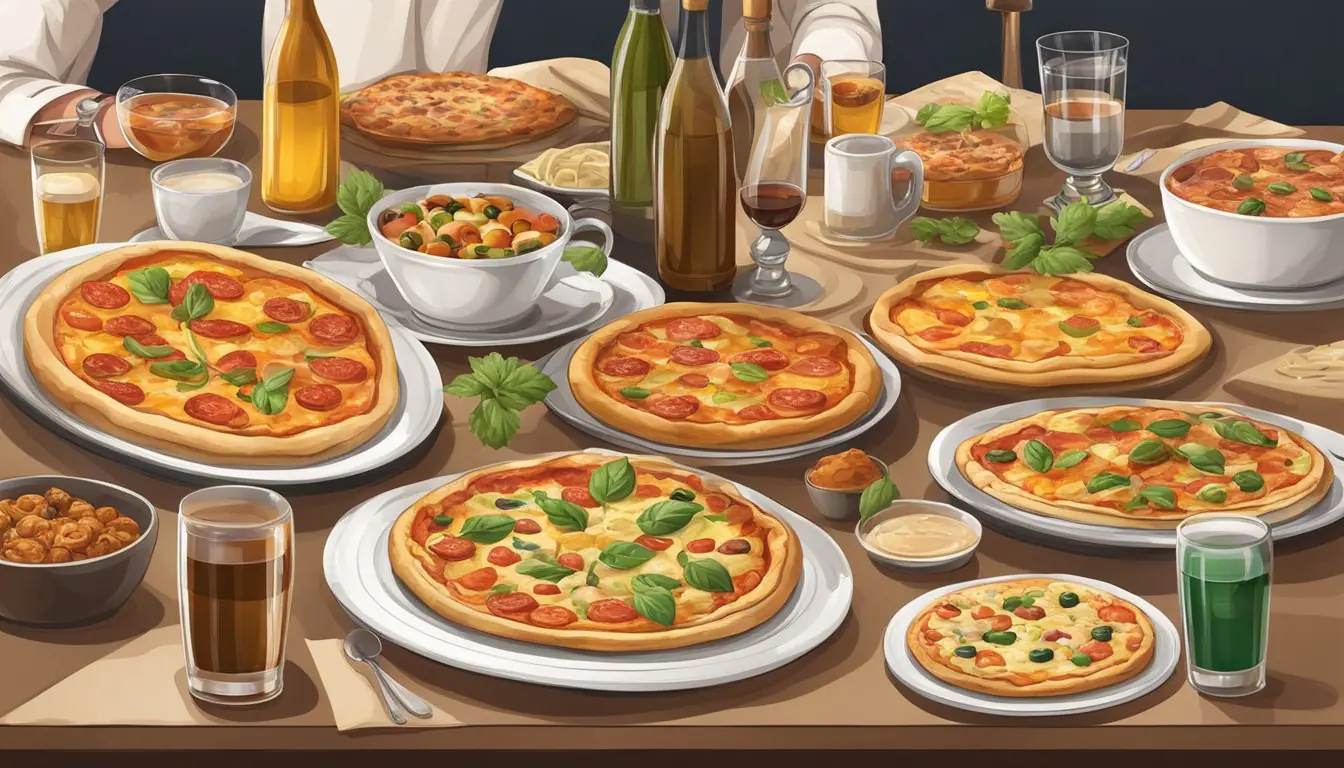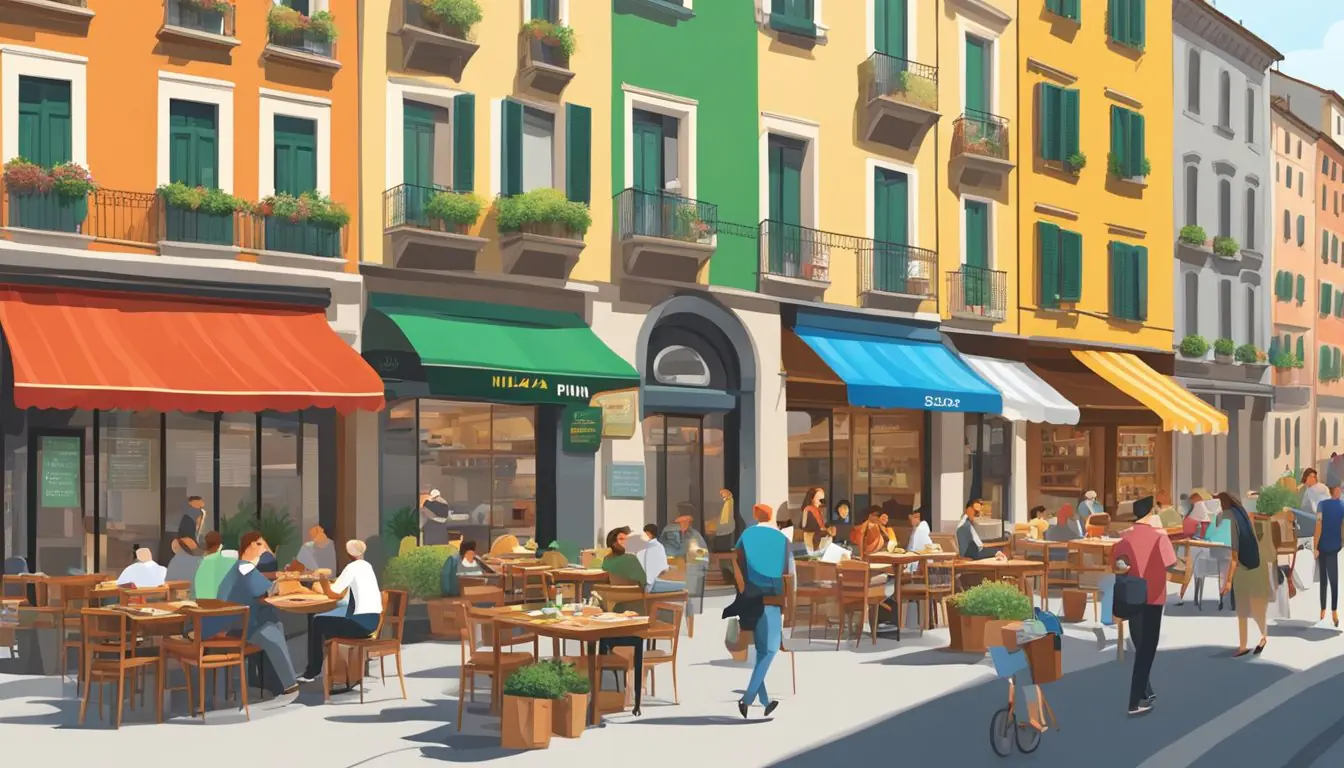Milan is often celebrated for its contributions to fashion and design, but its culinary scene deserves equal acclaim, particularly when it comes to authentic Italian cuisine.
Those interested in a traditional Italian dining experience are spoilt for choice in this metropolitan city.
For visitors and locals alike, exploring Milan’s food culture is a journey that can lead to delightful discovery of age-old recipes served with the same passion as they were centuries ago.
Rich risottos, succulent osso buco, and buttery cotolettas are just a snapshot of the traditional Milanese dishes that await gourmet adventurers.

While the allure of traditional dishes remains constant, there is no overlooking the universal love for pizza. Milan boasts some top-rated pizza places, where the commitment to quality ingredients and the art of pizza making is unmistakable.
From a thin and crispy crust to a dough that’s been leavened for over 48 hours – the city’s pizzerias cater to every nuanced preference of pizza enthusiasts.
Finding the best pizza in Milan can be a sumptuous slice of Italian life, combining the joy of simple, fresh flavors with the sophistication of culinary craft.
Where to eat traditional italian food
Key Takeaways
- Milan offers a wealth of traditional Italian dishes, from risotto to cotoletta.
- The city’s pizza scene is diverse, satisfying all preferences with quality ingredients.
- Exploring Milanese cuisine provides a taste of Italy’s rich culinary heritage.
Discovering Milanese Culinary Delights
Journey through Milan’s streets and one is enveloped by the scent and taste of traditional Milanese cuisine; a culinary tradition steeped in history and rich with local flavors that beckon the food lovers to indulge in plates like Cotoletta Alla Milanese and Risotto Milanese.
History of Milanese Cuisine
Milanese cuisine has evolved through centuries, interwoven with the city’s history as a hub of Italian culture and gastronomy.
Originally, Milanese dishes reflected the resources available in the fertile Po Valley, with staples like rice and maize forming the foundation.
The invention of iconic dishes such as Ossobuco and Polenta signify not just culinary delight but the ingenuity and resourcefulness of Milanese cooks throughout history.
Traditional Milanese Dishes
At the heart of traditional Milanese dishes lie simple ingredients transformed into exquisite meals.
Cotoletta Alla Milanese, a bone-in breaded veal cutlet, serves as Milan’s answer to the Wiener Schnitzel and is a must-try for meat lovers.
Meanwhile, Risotto alla Milanese, with its golden hues from saffron and rich buttery taste, perfectly captures the essence of Milanese flavor.
Another quintessential Milanese specialty, Mondeghili, are flavorful meatballs crafted from leftovers, exemplifying the no-waste culture of Milan’s culinary tradition.
Whether savoring these dishes in a time-honored trattoria or a contemporary Milanese restaurant, each bite speaks to the layered history and vibrant present of Milan’s gastronomic landscape.
Top Milanese Restaurants
Milan, renowned for its fashion and design, also boasts an array of culinary delights.
From Michelin-starred establishments revered by gourmands worldwide to traditional trattorias that serve authentic Milanese fare, the city caters to a range of palates seeking the true essence of Italian gastronomy.
Michelin-Starred Establishments
Milan’s Michelin Guide selections exemplify culinary excellence, with several restaurants awarded the prestigious Michelin stars for their outstanding dishes.
Ratanà, set in a restored historical building, is known for refining Lombard traditions with modern techniques, creating exceptional menus with local ingredients.
Another exemplary venue is Langosteria, renowned for its sublime seafood and elegant ambiance.
These establishments not only represent the pinnacle of Milan’s fine dining scene but also the creativity and innovation that define Milanese cuisine.
Traditional Trattorias
For a more rustic dining experience, Milan’s trattorias offer a deeply-rooted culinary tradition.
Antica Trattoria Della Pesa stands out as an institution serving Milanese staples, reflecting the city’s rich history through its authentic flavors.
Alternatively, 28 Posti impresses with its intimate setting and commitment to sustainability, featuring a menu that’s both innovative and respectful of traditional methods.
These traditional trattorias provide a charming, authentic experience, inviting patrons to savor the hearty and genuine tastes of the region.
Italian Dining Experience
Milan offers an array of traditional Italian dining experiences, from authentic menus to the intricate design and ambiance of fine dining establishments.
Diners can explore everything from family-style pizzerias to top restaurants in Milan, each offering unique tastes of Italy’s culinary heritage.
Understanding Italian Menus
Italian menus typically feature a range of courses designed to fully enjoy a meal.
Starters, known as “antipasti,” pave the way for “primi” (first courses) often consisting of pasta or risotto.
The “secondi” (main courses) usually feature meat, fish, or vegetarian options.
Exploring a traditional Italian menu often involves sampling local cheeses and cured meats, a hallmark of true Italian fare.
For those seeking a bite of top-quality pizza in Milan, establishments such as Meucci offer a friendly atmosphere and a taste of authenticity just five minutes from Sforza Castle.
Price points for various dishes can vary widely, from affordable pizzerias to more upscale dining options, thus catering to a broad range of preferences and budgets.
Fine Dining and Ambiance
Fine dining in Milan encapsulates more than just exquisite food; it’s about the total experience.
Upscale dining establishments often boast elegant design, attentive service, and often include outdoor seating to enhance the dining experience.
Fine dining restaurants are not just places to eat, but they are destinations showcasing the height of culinary artistry and the essence of Italian elegance.
Renowned spots such as Il Luogo di Aimo e Nadia, with its two Michelin stars, demonstrate this philosophy.
Diners can indulge in curated tasting menus that are emblematic of Milan’s rich gastronomic culture.
While the price at such venues can be higher, the meticulous attention to detail ensures a dining experience that is truly unparalleled.
Milan’s Food Culture
Milan, the pulsating heart of Italy’s gastronomy, offers an eclectic mix of traditional Italian fare alongside innovative, international options.
From the vibrant street food scene to cosmopolitan restaurant offerings, the city caters to all palates and dining preferences.
Street Food and Casual Eats
In Milan, street food and casual dining are synonymous with a rich variety of tasty options.
Travellers and locals alike revel in the city’s offerings, which range from succulent seafood to classic sandwiches.
A must-visit is Tipografia Alimentare, where one can indulge in gourmet selections that transform a quick bite into an unforgettable culinary experience.
Vegetarian options abound, reflecting the city’s commitment to diverse dietary needs.
Notable street foods include:
- Pizza: An ever-present delight
- Fish: Freshly prepared in myriad ways
- Sandwiches: Crafted with Italian flair and fresh ingredients
You won’t want to miss the renowned Altatto, a haven for vegetarians seeking innovative dishes that tantalize the taste buds while respecting the natural integrity of the ingredients.
Innovative and International Cuisines
Milanese cuisine is not just about tradition; it’s also about innovation.
Chefs like Diego Rossi are redefining Italian cuisine with a focus on locally sourced, high-quality ingredients.
At the cutting edge of this culinary revolution are destinations like Ribot, known for their inventive takes on classic dishes, and Erba Brusca, a restaurant where the surrounding vegetable garden is not just a view but a vital part of the menu.
These establishments reflect Milan’s status as a global city that not only preserves its culinary heritage but also embraces global gastronomic influences.
Beverages and Desserts

In Milan, a meal is not complete without indulging in its acclaimed beverages and desserts.
Visitors explore an array of celebrated Italian wines and spirits, alongside sweet Milanese specialties that leave a lasting impression.
Italian Wines and Spirits
Italian wines are integral to the Milanese dining experience. Menus often boast both familiar red wines and white wines, as well as natural wines.
Notable wine bars in Milan provide the perfect setting to enjoy these selections. They are often accompanied by knowledgeable staff who can articulate the nuances of each bottle.
Spirits also hold a place at Milan’s tables. Options like the refreshing lemon-infused limoncello showcase the best of Mediterranean flavors.
Sweet Treats of Milan
No visit to Milan is complete without sampling the city’s iconic desserts.
Gelato, Italy’s renowned frozen delight, takes on a myriad of flavors. These often highlight local ingredients such as olive oil or lemon.
Milan is also home to decadent pastries like tiramisu, a world-famous dessert layering coffee-soaked ladyfingers with a rich, mascarpone cheese mixture.
For those looking for a sophisticated end to their meal, a drizzle of balsamic atop vanilla gelato shouldn’t be missed.
Navigating Milan’s Dining Scene
Milan’s dining scene is an exquisite blend of tradition and innovation. It offers a range of options from cozy neighbourhood trattorias to high-end fine dining experiences.
Understanding how to approach the local restaurant culture is key. This includes making reservations and honoring dining etiquette. It can greatly enhance one’s culinary journey in this Lombardian capital.
Making Reservations and Dining Etiquette
In Milan, many restaurants, especially those offering fine dining, expect diners to make reservations in advance.
The bustling city draws not only tourists but also local patrons who value a scheduled dining experience.
One can typically make a reservation online or by calling the restaurant directly.
The dining etiquette in Milano is grounded in formality and respect for the culinary arts.
Diners should be prepared to take their time enjoying meals, especially in establishments that specialize in multi-course experiences.
For example, local favorites known for their cheese and butter dishes might suggest specific pairings and sequences of courses.
It is customary to dress smartly and arrive punctually, as Italians often view meals as an event rather than a quick necessity.
Exploring the Neighborhoods
Milan’s neighborhoods each offer a distinct dining experience.
While the city center boasts historic restaurants and elegant Galleria Vittorio Emanuele II cafés, venturing into different quartieri (districts) will lead to delightful encounters with charming neighbourhood trattorias.
The Navigli district, known for its canals, is one such area where visitors can indulge in traditional Italian dishes with a side of local atmosphere.
Furthermore, exploring beyond the well-trodden tourist paths can yield hidden gems.
These hidden gems are where authentic Milanese cuisine takes center stage.
Spore sourcing and integration of local ingredients define the essence of Milanese dishes, such as risotto allo zafferano or osso buco.
Diners who take the time to research and visit various neighborhoods will find themselves rewarded with a rich tapestry of tastes and culinary craftsmanship.
Milan as a Culinary Destination
Milan is renowned for its diversity in gastronomic experiences, ranging from traditional dishes like focaccia and pastas to innovative menus in starred restaurants.
Visitors can immerse themselves in the city’s culinary heritage and contemporary gastronomy. This reflects the unique blend of history and modernity present in Milan’s architecture.
Food Tours and Culinary Events
Food lovers can engage in an array of food tours that showcase the rich food in Milan.
These tours provide an opportunity to taste everything from street foods like focaccia to sophisticated dining experiences in renowned establishments.
Culinary events offer a deep dive into the gastronomic tradition.
They feature celebrated chefs like Enrico Bartolini who is known for his three Michelin stars achievements.
Participants can relish the authentic flavors of Milan’s cuisine.
Often, these tours culminate near landmarks such as the iconic La Scala Theater or the Galleria Vittorio Emanuele II.
Impact of Gastronomy on Tourism
Gastronomy plays a pivotal role in enhancing tourism in Milan.
The thriving food scene—comprising of elegant eateries like Joia, Milan’s first vegetarian restaurant awarded a Michelin star, and other starred restaurants—attracts food enthusiasts from all over the world.
These culinary institutions not only provide a sensory experience. They also showcase the city’s splendid architecture, further cementing Milan’s status as a must-visit destination for its food and culture.
Visitors are drawn to this intersection of food and art, solidifying the relationship between Milan’s culinary standing and its tourism appeal.
Conclusion
Milan is a city that offers an impressive array of traditional Italian cuisine.
For a deep dive into regional specialties, one might consider reserving a table at Trattoria Trippa.
This establishment is renowned for its preparation of Osso Buco, a classic Milanese dish that is a testament to the city’s rich culinary heritage.
Those in pursuit of authentic pizza should not miss Da Giacomo.
This eatery is celebrated for its exceptional offering of Neapolitan-style pizzas.
It stands as a memento to the fact that Milan’s restaurant scene caters to all variations of Italian food, with many eateries serving everything from pasta dishes to an extensive selection of Mediterranean cuisine.
Diners interested in Tuscan cuisine will find Gastronomia Yamamoto an intriguing fusion of Italian and Japanese culinary techniques.
This creates a unique dining experience that pays homage to both cultures.
For those who appreciate the simplicity of good, hearty fare, Milan’s traditional eateries like Cesare Battisti are destinations where guests can enjoy staple Italian Food such as risotto and cotoletta.
In summary, Milan offers an extraordinary tapestry of Italian gastronomy, from traditional to contemporary interpretations. Its restaurants are not just places to eat, but landmarks that embrace and showcase the essence of Italian culinary excellence.
Frequently Asked Questions

Milan is a treasure trove of culinary delights, featuring an array of pizzerias and authentic Italian eateries. For those seeking the perfect slice or a traditional pasta dish, this guide will steer you in the right direction.
What are some highly recommended pizzerias in Milan’s Duomo area?
In the shadow of the majestic Duomo, Spontini Pizzeria is renowned for its thick, cheesy slices that embody the traditional Milanese pizza style.
Food lovers also flock to Pizzeria Gino Sorbillo for its authentic Neapolitan pies.
Where can I find the best pasta dishes in Milan?
For pasta aficionados, Ristorante La Brisa offers a selection of exquisite pasta dishes with a touch of Milanese finesse.
Another gem is L’Antica Osteria del Ponte, where one can indulge in expertly crafted Italian pasta creations.
Which restaurants offer authentic Italian cuisine in Milan?
Eateries like Trattoria alla Cucina del Garga pride themselves on serving hearty, authentic Italian cuisine with a Milanese twist.
Il Luogo di Aimo e Nadia is a must-visit for its innovative approach to traditional Italian dishes.
What are the most famous places to eat pizza in Milan?
The iconic Pizzeria da Michele has established itself as a landmark for its world-famous pizza that keeps locals and tourists coming back.
Another esteemed spot is La Taverna, celebrated for its classic wood-fired pizzas.
How to locate top-tier pizza restaurants near Milano Centrale?
Near Milano Centrale station, Pizzium stands out for its signature pizzas that combine quality ingredients with tradition.
Just a short walk from the station, Pizza AM delights visitors with its vibrant atmosphere and mouth-watering pizzas.
Which are the top-rated pizza places in Milan according to local food enthusiasts?
Local food enthusiasts often rave about Marghe, which has gained popularity for its high-quality, artisanal pizzas.
Equally acclaimed, Pizzaiolo Gourmet draws in crowds with its gourmet interpretations of classic pizza recipes.
